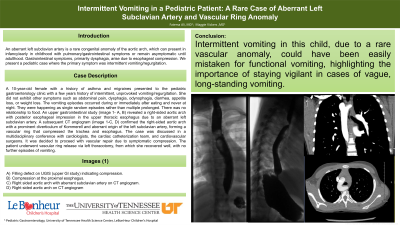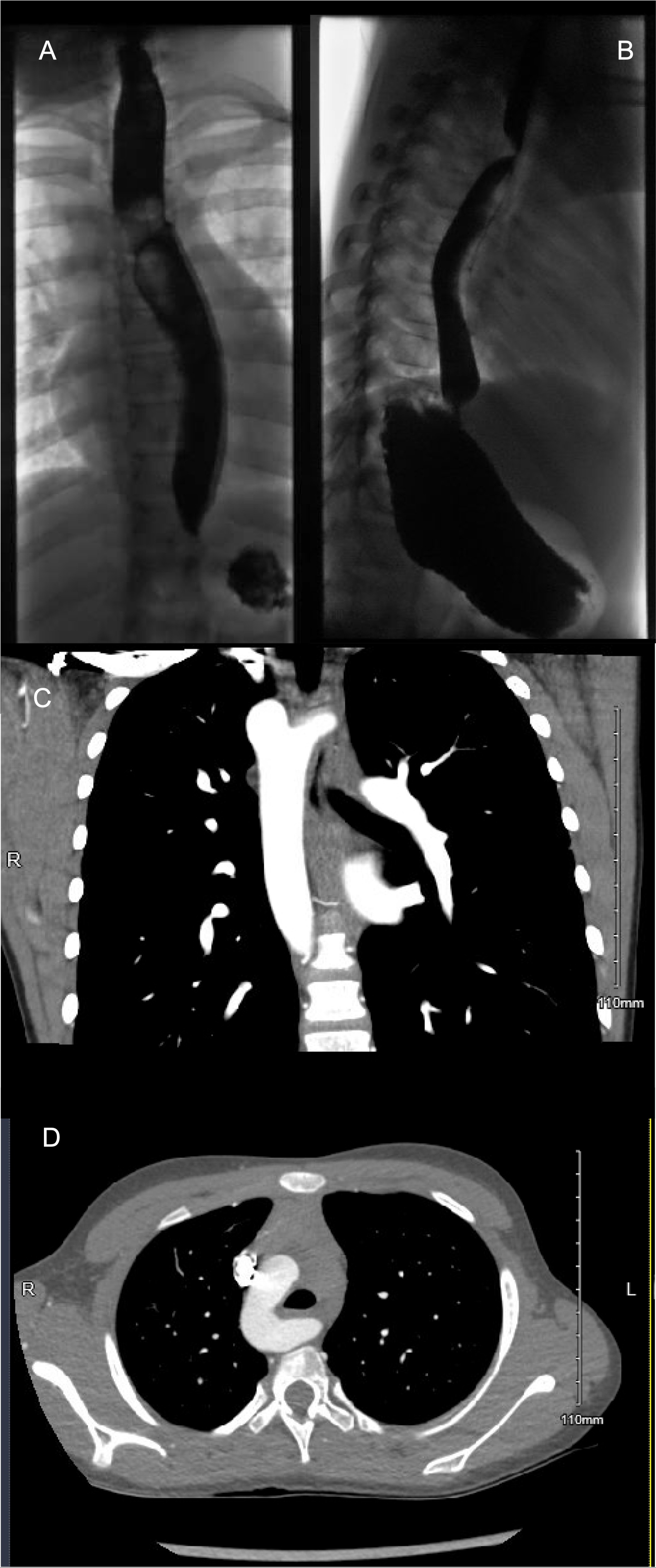Sunday Poster Session
Category: Pediatrics
P1474 - Intermittent Vomiting in a Pediatric Patient: A Rare Case of Aberrant Left Subclavian Artery and Vascular Ring Anomaly
Sunday, October 27, 2024
3:30 PM - 7:00 PM ET
Location: Exhibit Hall E

Has Audio
- FA
Fatema Ali, MD
University of Tennessee Health Science Center
Memphis, TN
Presenting Author(s)
Fatema Ali, MD, Maggie Vickers, MD
University of Tennessee Health Science Center, Memphis, TN
Introduction: An aberrant left subclavian artery is a rare congenital anomaly of the aortic arch, which can present in infancy or early childhood with pulmonary or gastrointestinal symptoms or remain asymptomatic until adulthood. Gastrointestinal symptoms, primarily dysphagia, arise due to esophageal compression. We present a pediatric case where the primary symptom was intermittent vomiting and regurgitation.
Case Description/Methods: A 10-year-old female with a history of asthma and migraines presented to the pediatric gastroenterology clinic with a history of intermittent, unprovoked vomiting/regurgitation for several years. She did not exhibit other symptoms, such as abdominal pain, dysphagia, odynophagia, diarrhea, appetite loss, or weight loss. The vomiting episodes occurred during or immediately after eating and never at night. They were happening as single, random episodes rather than multiple episodes or prolonged events. There was no particular food trigger. She was growing well and within healthy weight range. An upper gastrointestinal contrast study (image 1- A, B) revealed a right-sided aortic arch with posterior esophageal impression in the upper thoracic esophagus due to an aberrant left subclavian artery. A subsequent CT angiogram (image 1-C, D) confirmed the right-sided aortic arch with a prominent diverticulum of Kommerell and aberrant origin of the left subclavian artery, forming a vascular ring that compressed the trachea and esophagus. The case was discussed in a multidisciplinary conference involving cardiologists, the cardiac catheterization team, and cardiovascular surgeons. The team decided to proceed with vascular repair due to symptomatic compression of the esophagus. The patient underwent vascular ring release via left thoracotomy, from which she recovered well, with no further episodes of vomiting.
Discussion: This case represents an unusual presentation of a vascular ring anomaly, which could have easily been mistaken for functional vomiting given the intermittent nature of vomiting. It highlights the need for clinicians to be vigilant in evaluating cases of vague, long-standing vomiting.

Disclosures:
Fatema Ali, MD, Maggie Vickers, MD. P1474 - Intermittent Vomiting in a Pediatric Patient: A Rare Case of Aberrant Left Subclavian Artery and Vascular Ring Anomaly, ACG 2024 Annual Scientific Meeting Abstracts. Philadelphia, PA: American College of Gastroenterology.
University of Tennessee Health Science Center, Memphis, TN
Introduction: An aberrant left subclavian artery is a rare congenital anomaly of the aortic arch, which can present in infancy or early childhood with pulmonary or gastrointestinal symptoms or remain asymptomatic until adulthood. Gastrointestinal symptoms, primarily dysphagia, arise due to esophageal compression. We present a pediatric case where the primary symptom was intermittent vomiting and regurgitation.
Case Description/Methods: A 10-year-old female with a history of asthma and migraines presented to the pediatric gastroenterology clinic with a history of intermittent, unprovoked vomiting/regurgitation for several years. She did not exhibit other symptoms, such as abdominal pain, dysphagia, odynophagia, diarrhea, appetite loss, or weight loss. The vomiting episodes occurred during or immediately after eating and never at night. They were happening as single, random episodes rather than multiple episodes or prolonged events. There was no particular food trigger. She was growing well and within healthy weight range. An upper gastrointestinal contrast study (image 1- A, B) revealed a right-sided aortic arch with posterior esophageal impression in the upper thoracic esophagus due to an aberrant left subclavian artery. A subsequent CT angiogram (image 1-C, D) confirmed the right-sided aortic arch with a prominent diverticulum of Kommerell and aberrant origin of the left subclavian artery, forming a vascular ring that compressed the trachea and esophagus. The case was discussed in a multidisciplinary conference involving cardiologists, the cardiac catheterization team, and cardiovascular surgeons. The team decided to proceed with vascular repair due to symptomatic compression of the esophagus. The patient underwent vascular ring release via left thoracotomy, from which she recovered well, with no further episodes of vomiting.
Discussion: This case represents an unusual presentation of a vascular ring anomaly, which could have easily been mistaken for functional vomiting given the intermittent nature of vomiting. It highlights the need for clinicians to be vigilant in evaluating cases of vague, long-standing vomiting.

Figure: A) Filling defect on UGI series indicating compression B) UGI series showing compression at the proximal esophagus C) Right sided aortic arch with aberrant subclavian artery on CT angiogram. D) Right sided aortic arch on CT angiogram
Disclosures:
Fatema Ali indicated no relevant financial relationships.
Maggie Vickers indicated no relevant financial relationships.
Fatema Ali, MD, Maggie Vickers, MD. P1474 - Intermittent Vomiting in a Pediatric Patient: A Rare Case of Aberrant Left Subclavian Artery and Vascular Ring Anomaly, ACG 2024 Annual Scientific Meeting Abstracts. Philadelphia, PA: American College of Gastroenterology.
